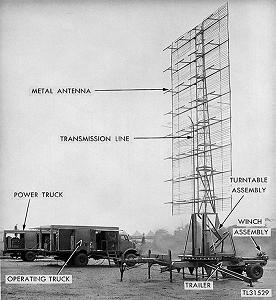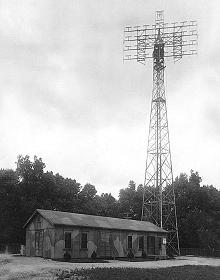SCR-270
Description of the radar set, tactical-technical characteristics

Figure 1: SCR-270
 Hersteller:
Hersteller:U.S. Army Signal Corps
(Transmitter made by Westinghouse)
| Specifications | |
|---|---|
| frequency: | 104 … 112 MHz |
| pulse repetition time (PRT): | |
| pulse repetition frequency (PRF): | 621 Hz |
| pulsewidth (τ): | 15 - 40 µs |
| receive time: | |
| dead time: | |
| peak power: | 100 kW |
| average power: | |
| instrumented range: | 250 stat. miles |
| range resolution: | |
| accuracy: | 4 stat. miles, 2 degrees |
| beamwidth: | |
| hits per scan: | |
| antenna rotation: | 1 rpm |
| MTBCF: | |
| MTTR: | |
SCR-270
SCR-270 (Abbr. of: Signal Corps Radio model 270) is an early mobile long wave aircraft warning set operating nominally at 106 MHz (≙ 2.83 m). The SCR-270 was one of the first mobile long-range early warning radar. Developed in the late 1930s, it was the US Army's primary long-distance radar throughout World War II. The antenna of a fixes site version (named SCR-271) was mounted on a tower.
The complete set is carried in 6 vehicles, the largest of which measures 30'4" x 9'10" x 8'. Total weight of shipment is 101,790 lbs; total volume 11,485 cu. ft. The radar operates from trucks in which mounted and can be placed in operation about 6 hours after arrival at site. Seven men comprise operating crew. For 24 hour operation about 50 men are required to run radar, communication radio, and camp. The needed power is 15.3 kW, supplied by PE-74, 25 kVA gasoline-driven generator, having fixed consumption of 4 gal. per hour, non-leaded gasoline.
SCR-270 is also known as the Pearl Harbor Radar, since it detected the incoming raid about half an hour before the attack commenced.
Picture gallery of SCR-270
Source:
- SCR-270-D Radio Set Technical Manual, 1942
- Dr. Wolfgang Holpp, The Century of Radar, EADS 2004
- 100 Jahre Radar (FGAN-FHR)

